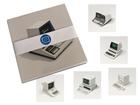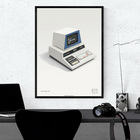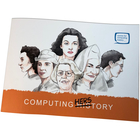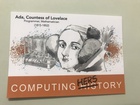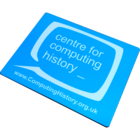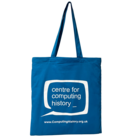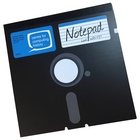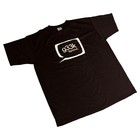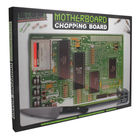
| Home > LEO Computers > LEOPEDIA > Other Memoirs, Reminiscences > John Aeberhard: Reminiscences around LEO |
John Aeberhard: Reminiscences around LEO
|
I was late on the scene as far as LEO was concerned. I joined English Electric LEO Marconi (EELM) as press officer in August 1966. My joining just happened to coincide with the publication of the very first issue of Computer Weekly and my first engagement was lunch with Jim Bonnett, the paper’s editor. A good start to a career in computer industry PR. I got the job after a series of interviews, but principally because I managed, in the last of them, to hit it off with David Caminer, having won a national award from the British Association of Industrial Editors for a newspaper with an 80,000 circulation that I’d edited for my first employer after a history degree at university, Michelin Tyre Company. After four years with Michelin I reckoned I knew pretty much all there was to know about tyres and there were these things called computers that were coming to the fore and were clearly offering a much wider horizon. As a non-technologist who could string words together quite readily my role lay largely in explaining technology to a lay audience. The lowest common denominator applied: if I understood something, others would too! So there I was in the EELM offices in Stag Place, Victoria, charged with publicising the new data processing machines that were rapidly spreading across industry and commerce, reporting to a PR manager, but also working directly with Caminer, an experience that was stimulating and unpredictable at the same time. Caminer was a manager who commanded respect by being on top of his subject and passionately so. He inspired loyalty, but also left some enemies in his wake. That didn’t always fit comfortably in the corporate world that was opening up beyond LEO. I was a fan, albeit he was the only manager I worked for who came close to physically assaulting me by grabbing my pullover during a heated discussion about what should go into Computerview, the new newspaper I produced for the company as an external PR vehicle.
I didn’t realise it at the time, but the LEO influence and, to some extent, its ethos was gradually giving way to the more corporate approach of English Electric. System 4, based on the IBM-compatible RCA Spectra designs, had been introduced to the market and was the focus of all marketing activity. I would still be writing stories about the Post Office and its LEO 326 computers with the occasional KDF9 press release thrown in there, but System 4, rightly so, was taking all the attention. At the same time English Electric brought in new management in the shape of Ken Barge whose impeccable credentials as a high-flying IBM salesman didn’t, shall we say, naturally fit with Caminer’s more direct hands-on management style.
A move of office from Victoria to a brand new building strung along a large part of the Euston Road – "Barge’s Folly” as it later came to be known - signalled the shift in culture. Not long after the move and the change of name to English Electric Computers came the shock of another merger. This time it was the big one – the consolidation of the two remaining representatives of the British computer industry, English Electric Computers and International Computers & Tabulators, into a single company, International Computers Limited, ICL. The white heat of technology that had so impressed Harold Wilson had led to his Labour government, in the person of Tony Wedgwood Benn, brokering the marriage. Like most mergers, it was not a marriage of equals. At one point it had looked as though English Electric would emerge as the dominant partner. In the event, it was ICT that dominated. From an English Electric viewpoint, the merger came at the wrong point in the product development cycle. The costs and the delays involved in the launch of System 4 and its acceptance by the market placed English Electric in the weaker position. In the event, the plum jobs in the new merged company went for the most part to the former ICT managers from Arthur Humphreys, managing director, downwards. The two sides in the merger had pursued quite different strategies from a technology viewpoint, with English Electric opting for compatible alignment with IBM and ICT preferring a non-compatible IBM strategy. This leads to one of those fascinating what-ifs of history. Who’s to say what would have happened to the British computer industry had it been English Electric rather than ICT driving the technology forward. From a personal standpoint, the merger was a bad one for me. I was suddenly not, as I had been with English Electric Computers, the company press officer and spokesman, which would have taken me to the Putney HQ. Instead, I was buried away in a basement office of Whiteley’s department store in Queensway in charge of PR for the ICL subsidiary companies, namely the service bureau company, ICSL, and a new company to be formed out of the supplies operations of the merged parties. ICSL management accepted me under sufferance as they had their own man lined up for the PR role. And the supplies company didn’t inspire me much as a must-do glamorous opportunity. In actual fact, the supplies company turned out to be a good learning curve. The brief I got from Ralph Woolf, the managing director, impressed me at the time and still does. It was simplicity itself. "You do what you want to do,” he said. "If it works out, fine. If it doesn’t, I’ll still be behind you, but you’ll be out of a job.” So it was me who named the company Dataset, who developed its corporate identity and who launched it on the market. What happened to it, I never really knew as not long afterwards I was summoned to meet with Cedric Dickens, ICL’s communications director. A vacancy had occurred in ICLs Putney HQ and I was being offered the job of ICL corporate press officer. A weight had been lifted off my shoulders and my career was back on the track. I relished the opportunity and set to with gusto, though I have to say my ideas of PR did not always mesh with those of my corporate managers. Cedric Dickens, a direct descendant of Charles, was one of the old school. There was a drinks cabinet in his rather spacious office, and though to my fairly certain knowledge he never indulged in working hours, his acclaimed mantra was, "A glass of champagne on the hour, every hour!” My time as corporate press officer in Putney was busy and demanding. Computers generally and ICL, in particular, as the flagship for British technology, were always in the public eye and there was much to promote. From a PR viewpoint the job was comparatively straightforward. Interest from the media, if not exactly a given, was easy to stimulate and story lines abounded. At the same time, however, some of the frustration I’d experienced in Whiteley’s department store basement lingered and it was not long before, in late 1969, I got, and accepted, another job offer, this one to join Honeywell’s computer operations as press officer for Northern Europe. I did feel some guilt at joining the enemy after waving the flag for the British computer industry for over three years. But I was career-minded, relatively young and the money. I stayed with Honeywell for 11 years, the last three of them running PR and advertising for Honeywell Information Systems Inc, the computer half of the Honeywell Corporation. When I left Honeywell finally towards the end of 1980, it was to return to the UK to start up my own PR company which I subsequently built into a market-leading high tech PR specialist, A Plus Group, eventually selling the company to New-York stock exchange-listed marketing powerhouse, Omnicom, and a management group. At the time, A Plus had some 65 employees and a turnover approaching £5m. I promptly retired at the relatively young age of 59, but, kept my interest in computers going as a voluntary trustee/director of a charity applying computer technology and its life-enhancing possibilities to the problems faced on a daily basis by people with disabilities. I changed the name of the charity to AbilityNet and helped it build from one centre in Warwick to an organisation of a dozen specialist centres operating nationally. By this time the millennium was approaching and my career in PR turned full circle as I renewed contact with LEO through David Caminer and other former management from the old days who had joined forces, at Caminer’s instigation, to establish a LEO Foundation. Caminer had this strong wish to see LEO’s pioneering role in business computing recognised by history. There was a danger, he thought, that others would usurp LEO’s position as the world’s first business computer and he determined to do everything in his power to see that this didn’t happen. Personal motives played a part in this. He, after all, had played the leading role in the development of LEO software. But it was broader than this. He was out to beat the Americans again and set the record books straight. First off there was a book – the first of several - co-authored by Caminer, Frank Land, John Aris and Peter Hermon. Next up was a broader PR campaign. It was at this stage that I was persuaded to join the Foundation at its regular meetings at Caminer’s home close by Richmond Park in East Sheen. Caminer and his management team had decided that a key part of the PR programme was to be a major business computing conference centred around the 50th anniversary of the first operational job to run on LEO, a bakeries’ valuation job for Lyons in November 1951. The Guildhall in London was to be the prestigious venue, the support of the Lord Mayor’s office was secured and the dates were fixed as the 5th and 6th of November 2001. It was to be my job to develop the PR materials for the conference and to get as much media visibility as possible leading into and through the conference. Others would work on getting a top line-up of big-name speakers for the conference programme. My first thought was to develop a theme for the conference, couched as widely as possible, and a special logo to promote it. Thus we arrived at "50 years of Business Computing” for use on all promotional materials. These materials had then to be produced, including a press pack focusing on the LEO story. The programme itself, however, was not to dwell on the past, but rather to be forward looking. To underline this, a £5000 prize, sponsored by the National Computing Centre, was to be awarded for a paper speculating on where computing was headed over the next 50 years. Beyond this I used my contacts to enlist the Wall Street Journal as a major sponsor of the conference – quite a coup to get America’s major business daily to support the claim of a relatively unknown British company to have developed the world’s first business computer! I took the paper’s senior technology editor to East Sheen to meet with Caminer, resulting in a major feature on the LEO story, and the paper also ran a series of free ads promoting the conference. I also recruited my former PR company, on a pro bono basis, to assist with the mechanics of information distribution and the lobbying of journalists. In the event – and at a time when the conference business in general was in the doldrums - the conference attracted an audience of some 240 people and a great deal of media coverage. There were many other initiatives undertaken by the LEO Foundation over the next decade to promote the LEO story – too many to cover in this summary paper – and my involvement continued. One, in particular, however, does rate a mention, namely a 60th anniversary media event hosted by the Science Museum in November 2011. A small tweak to the 50th anniversary logo meant we could use it again. And the same applied to the press materials. The press duly turned up to hear essentially the same story and to give it further widespread visibility. The Science Museum, moreover, was in the process of a major overhaul of its computer and communications gallery, resulting ultimately in LEO being featured in its new displays. The 60th anniversary Science Museum event was notable for one other reason. It was co-sponsored by Google, another PR coup matching the earlier Wall Street Journal sponsorship. Here again we had a market-leading US organisation – in fact, their foremost technology company – paying court to the LEO story. The Google contribution was substantial, involving their whole London-based external communications team, and including the production of a very professional promotional film. Later on this led to a public lecture extolling LEO at the London School of Economics by Eric Schmidt, Google’s worldwide boss no less. In many ways it was PR job done! And shortly after this event, the LEO Foundation, was dissolved as a separate charity, and its remaining assets and its PR baton passed to its sister organisation, the LEO Computers Society, a membership group of former LEO employees. I’m still involved, but now mainly in an advisory role. Occasionally, I get hands-on again, but sadly of late this has mostly involved contacts with obituary editors! The LEO story, much like the Windmill theatre in London during the war years, never closes!! This exhibit has a reference ID of CH54572. Please quote this reference ID in any communication with the Centre for Computing History. |
|


